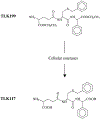The role of glutathione-S-transferase in anti-cancer drug resistance - PubMed (original) (raw)
Review
The role of glutathione-S-transferase in anti-cancer drug resistance
Danyelle M Townsend et al. Oncogene. 2003.
Abstract
Glutathione-S-transferases (GSTs) are a family of Phase II detoxification enzymes that catalyse the conjugation of glutathione (GSH) to a wide variety of endogenous and exogenous electrophilic compounds. GSTs are divided into two distinct super-family members: the membrane-bound microsomal and cytosolic family members. Microsomal GSTs are structurally distinct from the cytosolic in that they homo- and heterotrimerize rather than dimerize to form a single active site. Microsomal GSTs play a key role in the endogenous metabolism of leukotrienes and prostaglandins. Human cytosolic GSTs are highly polymorphic and can be divided into six classes: alpha, mu, omega, pi, theta, and zeta. The pi and mu classes of GSTs play a regulatory role in the mitogen-activated protein (MAP) kinase pathway that participates in cellular survival and death signals via protein : protein interactions with c-Jun N-terminal kinase 1 (JNK1) and ASK1 (apoptosis signal-regulating kinase). JNK and ASK1 are activated in response to cellular stress. GSTs have been implicated in the development of resistance toward chemotherapy agents. It is plausible that GSTs serve two distinct roles in the development of drug resistance via direct detoxification as well as acting as an inhibitor of the MAP kinase pathway. The link between GSTs and the MAP kinase pathway provides a rationale as to why in many cases the drugs used to select for resistance are neither subject to conjugation with GSH, nor substrates for GSTs. GSTs have emerged as a promising therapeutic target because specific isozymes are overexpressed in a wide variety of tumors and may play a role in the etiology of other diseases, including neurodegenerative diseases, multiple sclerosis, and asthma. Some of the therapeutic strategies so far employed are described in this review.
Figures
Figure 1
Glutathione conjugation to a generic xenobiotic (X) via GST results in the formation of a glutathione-S conjugate
Figure 2
Structure of TLK199 and activation via cellular esterases to the active GST inhibitor TLK117
Figure 3
Structure of TLK286 and its activation by GST_π_
Similar articles
- Advance in antitumor agents targeting glutathione-S-transferase.
Zhao G, Wang X. Zhao G, et al. Curr Med Chem. 2006;13(12):1461-71. doi: 10.2174/092986706776872934. Curr Med Chem. 2006. PMID: 16719788 Review. - Glutathione transferases as targets for cancer therapy.
Ruzza P, Rosato A, Rossi CR, Floreani M, Quintieri L. Ruzza P, et al. Anticancer Agents Med Chem. 2009 Sep;9(7):763-77. doi: 10.2174/187152009789056895. Epub 2009 Sep 1. Anticancer Agents Med Chem. 2009. PMID: 19538171 Review. - Glutathione S-transferases--a review.
Salinas AE, Wong MG. Salinas AE, et al. Curr Med Chem. 1999 Apr;6(4):279-309. Curr Med Chem. 1999. PMID: 10101214 Review. - Glutathione S-transferase: A versatile and dynamic enzyme.
Aloke C, Onisuru OO, Achilonu I. Aloke C, et al. Biochem Biophys Res Commun. 2024 Nov 19;734:150774. doi: 10.1016/j.bbrc.2024.150774. Epub 2024 Oct 1. Biochem Biophys Res Commun. 2024. PMID: 39366175 Review. - Spectrophotometric Screening for Potential Inhibitors of Cytosolic Glutathione S-Transferases.
Robin SKD, Ansari M, Uppugunduri CRS. Robin SKD, et al. J Vis Exp. 2020 Oct 10;(164). doi: 10.3791/61347. J Vis Exp. 2020. PMID: 33104076
Cited by
- Plant viruses exploit insect salivary GAPDH to modulate plant defenses.
Wang X, Wu H, Yu Z, Wu J, Lu C, Wei T, Chen Q. Wang X, et al. Nat Commun. 2024 Aug 12;15(1):6918. doi: 10.1038/s41467-024-51369-8. Nat Commun. 2024. PMID: 39134555 Free PMC article. - The Cancer Antioxidant Regulation System in Therapeutic Resistance.
Gu X, Mu C, Zheng R, Zhang Z, Zhang Q, Liang T. Gu X, et al. Antioxidants (Basel). 2024 Jun 27;13(7):778. doi: 10.3390/antiox13070778. Antioxidants (Basel). 2024. PMID: 39061847 Free PMC article. Review. - Exploring the impact of GSTM1 as a novel molecular determinant of survival in head and neck cancer patients of African descent.
Yang F, Chen F, Shay C, Chen GZ, Saba NF, Teng Y. Yang F, et al. J Exp Clin Cancer Res. 2024 Jul 23;43(1):203. doi: 10.1186/s13046-024-03127-3. J Exp Clin Cancer Res. 2024. PMID: 39044272 Free PMC article. - Untangling the adaptive strategies of thermophilic bacterium Anoxybacillus rupiensis TPH1 under low temperature.
Mishra A, Chakraborty S, Jaiswal TP, Bhattacharjee S, Kesarwani S, Mishra AK, Singh SS. Mishra A, et al. Extremophiles. 2024 Jul 17;28(3):31. doi: 10.1007/s00792-024-01346-2. Extremophiles. 2024. PMID: 39020126 - The glutathione S-transferase Gstt1 drives survival and dissemination in metastases.
Ferrer CM, Cho HM, Boon R, Bernasocchi T, Wong LP, Cetinbas M, Haggerty ER, Mitsiades I, Wojtkiewicz GR, McLoughlin DE, Aboushousha R, Abdelhamid H, Kugel S, Rheinbay E, Sadreyev R, Juric D, Janssen-Heininger YMW, Mostoslavsky R. Ferrer CM, et al. Nat Cell Biol. 2024 Jun;26(6):975-990. doi: 10.1038/s41556-024-01426-7. Epub 2024 Jun 11. Nat Cell Biol. 2024. PMID: 38862786
References
- Bakker J, Lin X and Nelson WG. (2002). J. Biol. Chem, 277, 22573–22580. - PubMed
- Brown GL, Lum RT, Schow SR, Maack C, Vollmer C, Gomez R, Delioukina M, Boulos L, Laxa B, Brown J and Rosen LS. (2001). TLK286: phase I dose escalation trial in patients with advanced malignancies.
Publication types
MeSH terms
Substances
LinkOut - more resources
Full Text Sources
Other Literature Sources
Research Materials
Miscellaneous


